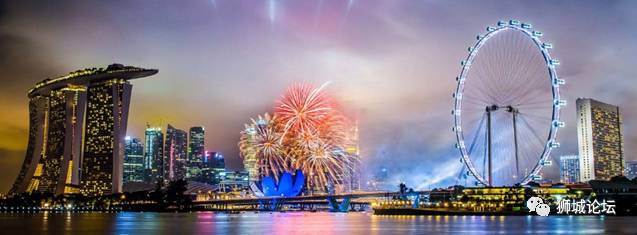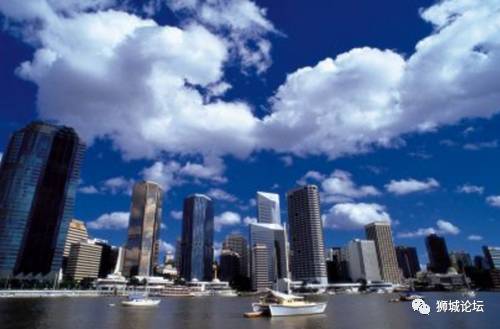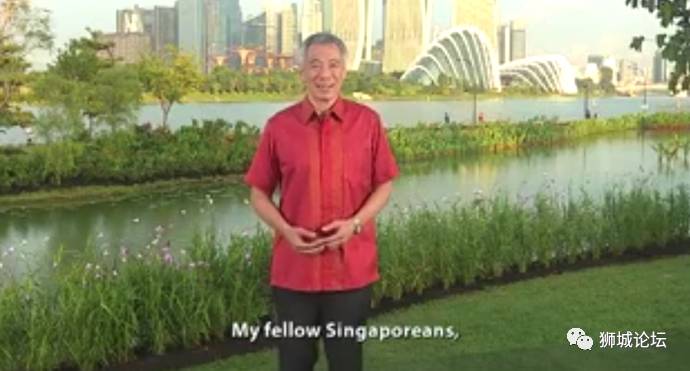獅城網 sgcn.com
新加坡最大中文生活門戶
微信:sgcn_com QQ:1390086
新加坡是東南亞的一個島國,梵文意爲獅子城,又因國土小如星鬥,故稱星洲、星島。新加坡國土總面積618平方千米,人口約有270萬,其人口密度每平方千米高這4369人。是世界上面積最小、人口密度最高的國家之一。
1965年獨立後,立足本國實際,因地制宜,實行對外開放政策,經濟迅速發展,成爲世界上經濟增長最快的國家之一。
究其發展的根本原因,主要是充分發揮其優越的地理位置這個有利因素,成爲世界上利用地理位置發展經濟的典型國家。
一、優越的地理位置
新加坡位于馬來半島最南端,領土由新加坡島和附近54個小島組成,地理位置十分重要,向稱“東方十字路口”。北面與馬來半島隔著寬僅1.2千米的柔佛海峽,西邊有長堤相連,交通便利;在南面隔著新加坡海峽同印度尼西亞相望,海峽長105千米,寬1.7千米,扼守著馬六甲海峽入口處的航行要道。
二、利用地理位置發展經濟
新加坡地狹人稠,資源貧乏,依靠其得天獨厚的地理位置發展經濟,成爲東南亞的經濟中心,主要表現在如下四個方面:
1、國際航運、航空和貿易中心 新加坡港地理位置優越,氣候和水文條件十分理想,港口貨物年吞吐量達1億噸以上,居世界前列,國際航空客運周轉量僅次于美、英、法、日居世界第5位。新加坡以此爲基礎,從鄰國大量進口各類初級産品,彙總、分級、包裝後再行出口,形成了以轉口貿易和航運業爲主體的獨特經濟類型。
2、工業和技術服務中心
新加坡四面環海,以煉油和造船爲核心的工業部門具有世界意義。全國建有五大煉油廠,年加工能力達4290萬噸,成品油出口額僅次于荷蘭居世界第二位。造船業爲傳統的優勢部門,不僅能修造繁多的各項船舶,還是世界上海洋石油鑽井平台的主要生産基地之一。自20世紀70年代後期,工業以制造業爲中心轉向技木密集型部門,大力發展電子工業,電視傳真設備、按鈕式電話、光纖光纜、電腦化列車控制系統等均進入世界先進行列。近年來,發展重點又轉向新科技園地的建設上,大力培養科技人才,發展尖端技術,以適應改革工業結構的需求。
3、投資和金融中心
新加坡由于優越的地理位置,方便快速的通訊,政局的穩定,國民素質較高等特點,使外國資本大量投入,推功了新加坡經濟的騰飛。同時,各國銀行雲集新加坡,銀行總數僅次于倫敦、紐約和香港,成爲世界第四大金融中心。
4、國際旅遊和會議中心
就自然和曆史文化條件而言,新加坡並不具備發展旅遊業的突出優勢,但利用其適中的地理位置,大力發展基礎設施,美化城市環境,提供優質服務,簡化出入境手續,開展各種旅遊“外交”活功,從而吸引大量外國遊客旅遊及大批國際會議在新加坡召開。目前,旅遊業已成爲新加坡外彙的重要來源之一。
“
總之,新加坡利用本國特殊的地理條件,揚長避短,引進和運用外國資金、技術和管理經驗,使生産力水平得到了迅速提高,走出了一條獨特的成功的經濟發展道路。這一成功道路不僅爲類似新加坡這樣的島國提供了發展模式,同時也爲世界各國經濟的發展提供了寶貴經驗。
”
而今天,新加坡迎來了它的52周年生日,李顯龍一早就發表了祝福,一起來看看總理說了什麽吧!
中文版
各位同胞:
這裏是濱海東花園。
建國初期,這個地方曾經是一片大海。當時,我們的建國領袖從岸邊看過去,看到的不是海水,也不是土地的局限。他們想象到的,是一個朝氣蓬勃的城市,一個集合了商業、居住和休閑用途的生活天地。
在接下來的幾十年裏,我們在濱海灣中心、濱海南和濱海東一帶進行填土,將建國領袖的願景化爲現實。今天,我們在濱海南打造了一個嶄新的金融中心,也建造了濱海堤壩和濱海灣花園。濱海灣迷人的風景線成了新加坡的新地標,深受世界各地遊客的贊賞,讓我們倍感驕傲。
當年,建國領袖們在構思和規劃濱海灣的時候,我國正面對許多更爲迫切的問題。這包括建立武裝部隊、吸引外資、創造就業機會、興建房子、還有爲下一代年輕人提供教育。盡管如此,建國領袖和人民都明白,除了解決眼前的問題以外,他們也必須放眼未來,做好長遠規劃。有了他們的遠見和付出,新加坡才有今天的成就。
52年後的今天,新加坡同樣有許多迫切的國內外事務需要解決。目前的國際局勢複雜多變。世界各地有更多的恐怖事件發生,本區域也不能幸免,恐怖主義是個重大威脅。貿易保護主義的擡頭,影響我們的對外貿易和經濟增長。我們正致力于提升國家的經濟實力。爲此,我們的學生和工友們已經在加快學習步伐,掌握新技能和尖端科技。
爲了克服這些挑戰,政府正同大家緊密合作,並取得一些進展。我們正加大力度,對抗極端恐怖主義的威脅,而當中一項重要的工作,就是加強種族和諧。在經濟方面,勞資政三方正在攜手合作,幫助各行各業轉型和協助工友提升技能,爲未來經濟的需求做好准備。今年,我國經濟有望取得百分之2.5左右的增長,比去年進步。
不過,在解決眼前問題時,我們也必須把眼光放遠,爲克服明天的挑戰做好准備。今年,我想談三個工作重點:加強學前教育、對抗糖尿病和實現智慧國願景。這三方面的相關措施將對國家和人民帶來長遠影響,爲我們的下一代打下更好的基礎,幫助國人保持健康和掌握數碼時代的機遇。
首先,我們希望每個孩子都能打下紮實的基礎,爲未來做好准備。我們相信學前教育對孩子們的學習和人生,有著非常深遠的影響。我們因此建造了更多的幼兒園和托兒所,並且會繼續增加更多學額,加強教師的培訓,提升學前教育的素質。
孩子們有了更好的學習環境和更好的照顧,家長們就能更加安心工作。我們希望通過這些措施,鼓勵更多國人組織家庭和生兒育女。
第二,我們希望新加坡人健康長壽。我們的醫院設施完善,也有優秀的醫療團隊。但是,保持健壯的體魄,不讓疾病纏身,才是關鍵所在。雖然新加坡人現在的平均壽命更長,但是許多年長國人在他們人生的最後八年,往往會面對健康問題。對老人家來說,這是漫長的煎熬,對家屬來說,也是沉重的負擔。
糖尿病是年長國人最常患上的一種疾病。60歲以上的國人,每三個人當中就有一個人患有糖尿病。糖尿病的初期症狀不明顯,但是日子久了,可能導致嚴重的並發症,例如失明、心髒疾病、腎衰竭,甚至必須截肢。
要全面有效對抗糖尿病,除了政府的相應政策和醫療服務,個人也必須調整生活方式,注意飲食習慣,多運動,多喝水,少喝汽水,最好從小就養成這些好習慣。
第三,爲了打造更宜居的生活空間和更理想的工作環境,我們要善用科技,把新加坡發展成智慧國。我們有自身的優勢。我們的數碼網絡覆蓋面廣,銜接度高,人民的數碼能力也強。我們擁有的手機數目甚至比人口還多! 但是我們還有不足的地方,需要做得更好。
比如,有些國家已經廣泛使用電子付款,跑在“無現金社會”的前端。另外一些城市則普遍采用感應系統加強公共保安,還有一些城市則利用大數據來改善公共服務。我們必須向這些國家看齊,趕上他們的步伐,並設法超越他們。我們要把科技應用到生活的各個領域,爲新加坡人創造更多機會,提高生活素質,爲社會增添創新活力。
我會在國慶群衆大會上,進一步談這三個課題。建國初期,我們的領袖爲今日的新加坡打下基礎,我們也應該爲下一代開拓未來;濱海灣的發展就是一個好例子。
建國元勳紀念堂指導委員會過去一年多來,就紀念堂應該建在哪裏,多次向公衆征詢意見,多數人都支持把紀念堂建在濱海東花園,政府已經接納了這個建議。從濱海灣的風景線,我們可以看到建國先輩的深謀遠慮,爲我們帶來了今天的成就,而我們也會繼續爲新加坡的未來發展而努力。已故建國總理李光耀先生曾經這麽問過:
“最終,作爲政府,我們應該對誰負起最大的責任?”
而他的答案是:“最重要的是對未來的一代,而不僅僅是這一代,更不是過去的一代。”
這就是所謂的新加坡精神:我們不斷地以前瞻性的思維規劃未來,保持競爭優勢。我們時時刻刻做好准備,迎接未來。這是我們的生存之道。讓我們一起努力,爲我們和我們的下一代開拓更多機遇。
祝大家國慶日快樂!
英文版
My fellow Singaporeans,
I am at Bay East Garden, the easternsection of Gardens by the Bay.
When Singapore became independent, thisspot was open sea. But looking out from the shore, our founding leaders didn’tjust see water and the constraints of geography. They imagined a bustlingcommercial, residential and lifestyle hub, a vibrant new downtown for the city.
So decade by decade, we reclaimed andbuilt Marina Central, Marina South and Marina East, and turned that vision intoreality. Today, we have a new financial district in Marina South. We have theMarina Barrage and the Gardens by the Bay. We take pride in the Marina Bayskyline, which is recognised and admired around the world.
During the years when Marina Bay wasconceived and planned, Singapore had to deal with many pressing concerns. Wehad to build the SAF, attract investments, create jobs, house our population,and educate our young. But our leaders and people understood the need to lookbeyond these immediate problems and prepare for the more distant future. Now weare enjoying the rewards of their foresight and vision.
52 years on, we too are preoccupiedwith urgent issues, domestically and externally. The world is unsettled and theoutlook uncertain. Terrorism is a major threat, with frequent attacks aroundthe world and closer to home. International trade, a key engine of our growth,is at risk from protectionism. We are busy upgrading our economy. Our studentsand workers are mastering new skills and staying up to date with technology.
The Government is working with you onthese issues, and we are making progress on them. We are stepping up vigilanceto protect ourselves against extremist terrorism; and one major task is tostrengthen our racial harmony. We are working with businesses and workers totransform industries one by one, and to prepare for the future economy. This yearwe expect growth of around 2.5%, higher than last year.
But even as we deal with these presentissues, we must also look beyond the horizon, and prepare for the future. Thisyear, I would like to share with you three things that will benefit us in thelong term: preschool, the war on diabetes, and a Smart Nation. These willenable us to start right, stay healthy, and work smart.
First, we must prepare youngSingaporeans for the new world. We want every child to have a good start inlife, and a bright future. We have been investing in preschools, because theearly childhood years make a big difference to children not just academically,but for life. We will create more preschool places, raise the quality ofpreschools, and upgrade the profession of preschool teachers.
More and better preschools will alsotake a major load off parents. Parents will have peace of mind when they areworking, knowing that their kids are in good hands. We want to support them andencourage them to start a family.
Second, we want Singaporeans to livelong and stay healthy. We have good doctors and hospitals. But actually it ismuch better for us to stay healthy and not have to go to hospital at all!Singaporeans are living longer today. But our elderly experience an average of8 years of poor health at the end of their lives. 8 years is a long time andcan also be a burden for the families.
One big reason for ill health in oldage is diabetes. Almost a third of those over the age of 60 have diabetes. Atfirst, diabetes is an invisible disease. But over time, its consequences aresevere – blindness, heart disease, kidney failure, amputated limbs.
This is why we must go all out to fightdiabetes. It is not just about more hospital facilities and better treatment.It also depends crucially on personal choices and lifestyles, to preventdiabetes in the first place. Each one of us must take responsibility for ourown health. Each one of us must make the effort to watch our lifestyle anddiet, to exercise regularly, to drink plain water instead of soft drinks. Andthis must start from young. That is the way to reduce the risk of diabetes,stay healthy, and live well.
Third, we want to make full use of ITto create opportunities and jobs for ourselves, and make Singapore an outstandingplace to live, work and play. This is why we aim to be a Smart Nation. We havea natural advantage: we are a highly-connected and digitally literate society;we even have more smartphones than people. But we need to do much better.
Other countries are using electronicpayments to go cashless, building sensor networks to enhance public security,and analysing big data to improve public services. We must learn from them,catch up, and get ahead. By using IT for practical applications, big and small,we can improve our lives, and make this a fun and happening place.
I will speak more on these three issuesat the National Day Rally. We need to look ahead and build for the nextgeneration, just as our forefathers looked ahead and built for us. Here at BayEast we can see how well this has worked for Singapore, and how our generationcan keep on doing this.
When the Founders’ Memorial Committeesought views from the public on where to site the Founders’ Memorial, a clearmajority of you supported Bay East. This is a wise choice, which the governmenthas accepted. Here, looking across the Bay and beyond, we can remember thevalues of our founding leaders, see what they have built, and commit ourselvesto continue building Singapore.
Mr Lee Kuan Yew once asked: “At the endof the day, whom do we owe our deepest obligation to as a government?”
And his own answer was: “To the future.Not just to the present; Certainly not to the past.”
This is the spirit of Singapore. Alwayslooking ahead, planning ahead, and staying ahead, so that when the futurearrives, we are prepared for it, to ride it and to grow with it. That is how wegot here. That is what we must keep on doing together, to open up freshopportunities for ourselves and our children.
Happy National Day.





